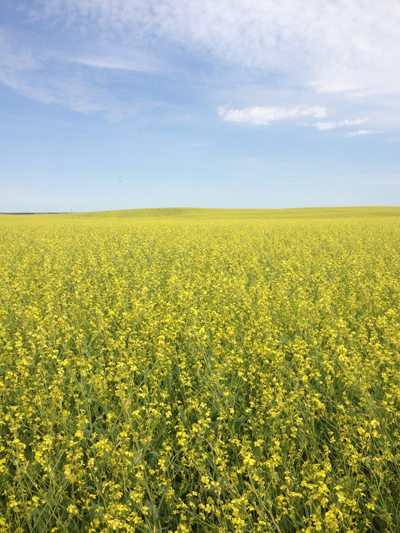Pass the Mustard: Why carinata is taking root as biofuel
 Navigant Research forecasts that biofuel production will reach 61 billion gallons by 2023, worldwide. Accordingly, as this occurs, one can count on the alternative fuel source replacing “nearly six percent of global transportation fuel production from fossil sources and generating $70 billion in new revenue over the next decade” (www.navigantresearch.com).
Navigant Research forecasts that biofuel production will reach 61 billion gallons by 2023, worldwide. Accordingly, as this occurs, one can count on the alternative fuel source replacing “nearly six percent of global transportation fuel production from fossil sources and generating $70 billion in new revenue over the next decade” (www.navigantresearch.com).
To meet this demand, an appropriate crop that can provide biofuels without competing for land use with food crops, is clearly needed. Fortunately, the emergence of non-food feedstocks to provide for the international biofuel demand is on the horizon. In fact, it seems the “Holy Grail” of non-food feedstocks is already available. A proprietary, non-food energy feedstock crop exists that yields oil, which is not only being refined into fuel meeting the specifications of petroleum-based fuels, but is also working in existing engines without any blending.
This new kid on the biofuel block taking root is the carinata seed. Carinata is a leafy plant, originating in Ethiopia. Also referred to as Ethiopian mustard and Abyssinian mustard, it produces oil seeds that can be (and have been) used as a biofuel, which mimic the attributes of its petroleum-derived counterpart. The oil seeds also work in ground and air transportation engines, and without engine modifications or blending.
To date, carinata has demonstrated agronomic success across 60 commercial sites and farms in the Canadian and the US prairies.
Exploring feedstocks
Feedstocks for biodiesel are in high demand. Various raw ingredients for biofuel have been tested and employed, including corn, soybean, algae, sugarcane, and waste products. Approximately 33% of the corn crop in the United States in 2013, representing $2.6 billion in crop seed sales, is used as feedstock for ethanol. But, ethanol can’t be used to make biodiesel as it’s not an oil-based feedstock.
Soybean and canola oils have been traditionally used, however, the costs of these food grade oils somewhat limit their use in biofuels. To ensure the future growth of biofuels, non-food crops need to become the primary source of feedstock.
The New York Times recently reported that the growth of the biofuels industry has created a scarcity of land for food crops in regions of Asia, Africa, and Latin America. Moreover, the amount of feedstock derived from food crops is already at the limit allowed by law, so all new growth will need to be from “advanced biofuel” sources. Biodiesel is the only certified “advanced biofuel” under this standard and, therefore, represents the most direct opportunity to gain market share.
Crops, such as carinata, offer marked benefits here. Aside from presenting a non-food source, carinata lowers the input costs for crop production while providing greater yields of oils. As such, these seeds offer farmers with a strong cash crop an alternative. This is especially true when carinata is grown on less expensive farmlands, which can be done without concerns, and as part of a rotation strategy that can utilize fallow lands.
Meeting standards
The International Air Transport Association (IATA) seeks to decrease net carbon dioxide emissions by 50% by 2050, in comparison to 2005 levels. The Renewable Fuel Standard, developed by the Environmental Protection Agency (EPA), is a federal program requiring that transportation fuel sold in America contain a minimum volume of renewable fuels. Originating with the Energy Policy Act of 2005, and extended in the Energy Independence and Security Act of 2007, the standard mandates 36 billion gallons of biofuels usage by 2022, with a maximum of 15 billion gallons derived from food crops—and, a minimum of 21 billion gallons from advanced biofuels.
The biodiesel fuel customer base includes commercial ground transportation, the military (who have legislated 50% biofuel content by 2017, and 100% by 2025), and the aviation industry (who are certifying 50% biofuel content by 2020).
The use of biojet fuel from non-food sources can help meet those goals. The production of carinata substantially reduces carbon and other harmful emissions, and helps to reduce global petroleum dependence. Carinata has been successfully used to produce a drop-in jet fuel that’s compatible with existing jet engines without any engine modifications.
Carinata was certified as a feedstock under the Roundtable for Sustainable Biomass. In 2012, it was used to power the world’s first civil aviation flight, with the NRC Flight Research Laboratory, powered by 100% biofuel derived from carinata.
Creating value
After crushing the carinata oilseeds and extracting the oil, the residual is ground into a co-product meal for use in cattle markets. This is essential to the overall crop value proposition, as it recaptures so much of the costs, while assisting in the economic viability of this burgeoning biofuel. When the meal’s full value is achieved and at scale, the cost of producing biofuel with carinata is cost-competitive for energy customers.
Based upon the yields per-acre and the make-up of the carbon chains within the oilseed, carinata also offers a higher efficiency than the next-best performing oilseed in existence today. In short, it can produce more fuel per acre on semi-arid lands than any other oilseed in existence today.
Last year, a working group comprised of representatives from energy companies, US national laboratories, and a Canadian national laboratory, extensively tested ReadiDiesel (refined from carinata) against nine other renewable diesels. The results: the carinata-based diesel looked more like petroleum-derived fuel than the others. In fact, the carinata-based diesel met the specification for petroleum diesel. This is significant because that fuel could be used 100% unblended as a petroleum substitute.
Biodiesel and biojet fuels can only be manufactured from oil feedstock, representing a combined opportunity that’s similar to, if not larger than, ethanol. This opportunity translates into a minimum of six billion gallons of feedstock for biodiesel applications, and up to 30 billion gallons of feedstock for biojet fuel in the next decade.
Demand will increase the market for feedstock from non-food crop seeds to one billion dollars over the next decade. And, carinata is uniquely positioned to be the feedstock of choice to meet this new market.
Don Konantz is the president and CEO of Calyx Bio-Ventures, an agricultural technology company focused on renewable fuels, including biojet and biodiesel.
Calyx Bio-Ventures
www.calyxbio.com
Author: Don Konantz
Volume: July/August 2014











